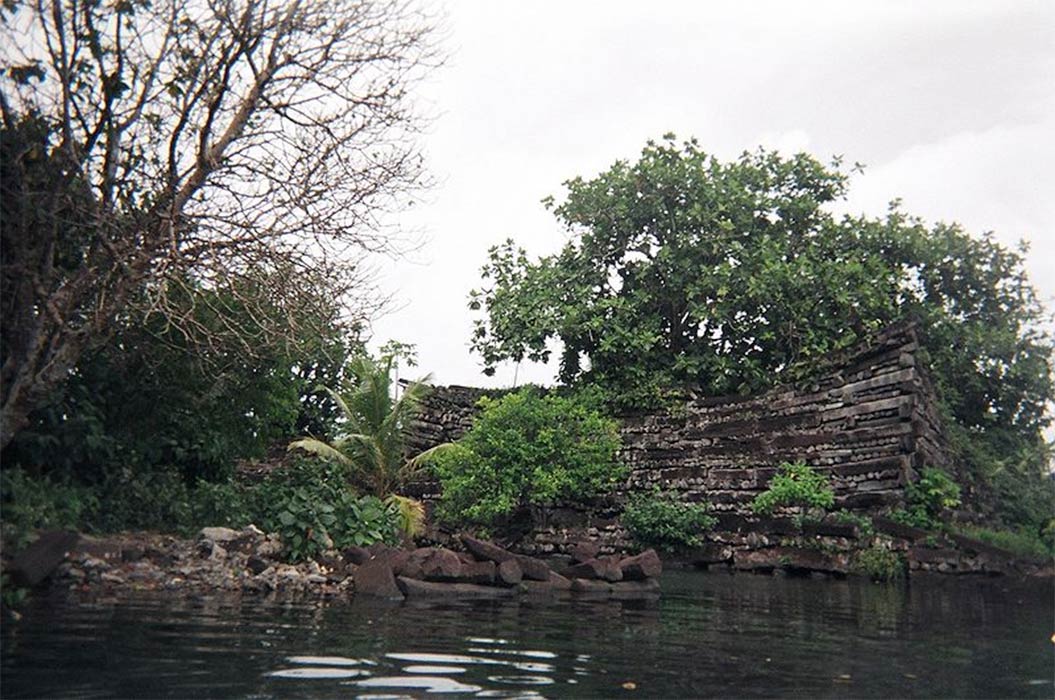
The Enigma Of Nan Madol: Home of Pre-Flood Stone Gods
Nan Madol is a mysterious place, there is nothing like it the world over. Its people are vanished and its purpose spectacularly obscure. Was it built by the mythical brothers Olishipa and Olosohpa, in honor of the god of thunder Daukatau, or to commemorate the sunken cities off the coast?
Known traditionally as Soun Nan-leng (‘Reef of Heaven’), Nan Madol is a megalithic complex made up of over 90 man-made islets built on coral fill and spread 200 acres over a lagoon edging Pohnpei’s surrounding barrier reef. Pohnpei (formerly Ponape) is the third-largest member of the Federated States of Micronesia, a spray of over 600 islands so-named after their minuscule size. Pohnpei is a compound meaning ‘upon an altar’, in reference to a cloud-capped mountain at the island’s center: at its summit is a basalt altar and a mangrove tree which symbolically represents the birth of the isle from its ocean bed. Nan Madol, popularly referred to as the ‘Venice of the Pacific’ perches upon the southeastern coastline of Pohnpei. Nan Madol means ‘spaces between’.
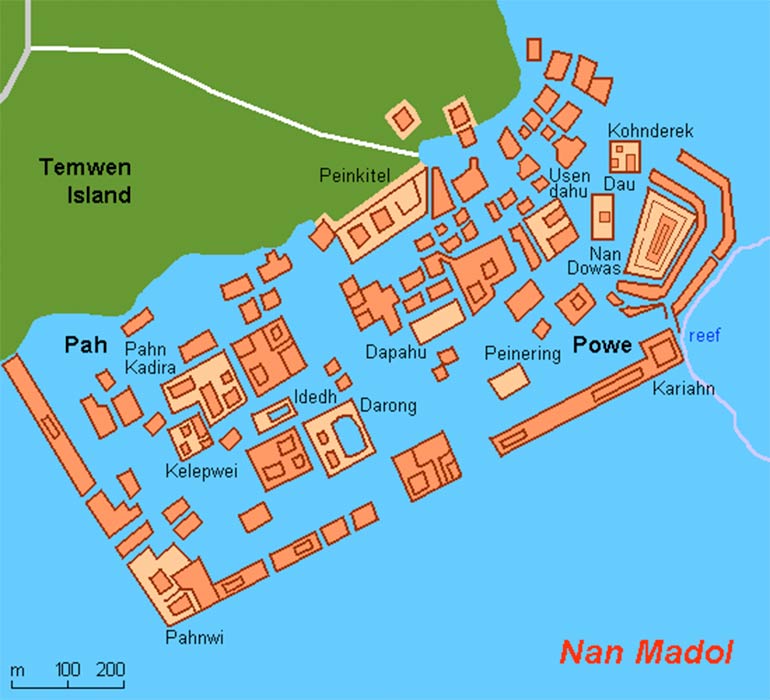
Map of Nan Madol. Federated States of Micronesia (Public Domain)
Venice Of The Pacific
The rectangular buildings of this megalithic metropolis are assembled out of massive boulders and tidily stacked piles of prismatic basalt. The four-to eight-sided columns of this dark, dense and smooth material formed millions of years ago. Guarding Nan Madol from battering ocean tides are the ruins of breakwaters along its coast, while running around and in between the islets is a network of connecting waterways. Today, the majority of crisscrossing canals are glutted with mangrove swamps, while thick tropical growth smothers nearly all of the islets. If left unchecked, the invasion of jungle will devour the entire site - and initiatives to restrain it are not forthcoming. Pohnpei is a hotspot attracting divers and big fish anglers, but sadly not visitors to its megalithic ruins. Many native Pohnpeians are also loath to visit the site, especially at night, since they believe Nan Madol is haunted by ancient spirits which should not be disturbed.
Currently it is thought construction of the site dates back no more than 1,500 years, although earlier foundations have been documented along with evidence of remodelling by successive occupants. Modern scientific research of the complex began in the 1960s and has largely been confined to topography and surface inspection.
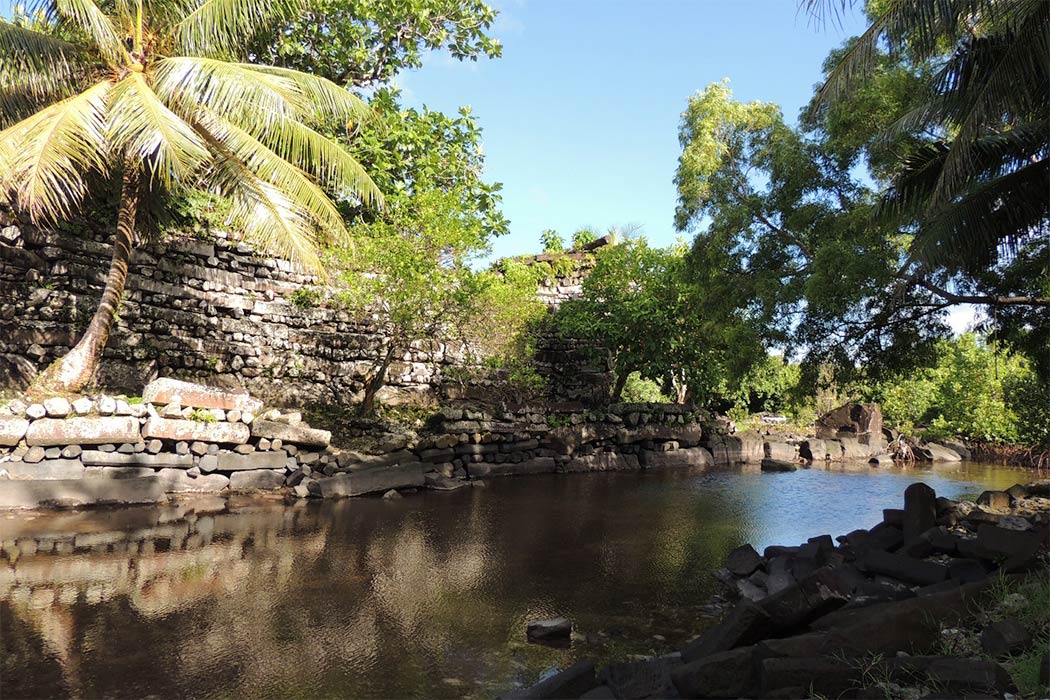
Pool at Nandauwas (Image: © Alistair Coombs)
Literary References
The site has unsurprisingly been the subject of several thriller novels with an underwater component, such as James Rollins’ Deep Fathom and Clive Cussler’s Medusa. The renowned author of cosmic horror, H.P. Lovecraft, apparently based his R’lyeh (a sunken city home to alien monsters from outer space) on Nan Madol. One of Lovecraft’s contemporaries, Abraham Merritt, featured the site in his The Moon Pool (1918) which became a popular novel in the 1920-30s. Hidden within the undersea tunnels and caverns of Nan Madol, is a magma chamber, the threshold of a dreaded being known as the Dweller, and the appearance of unusual light phenomena: “ In front of me was a pool. It was circular, perhaps 20 wide. Around it ran a low, softly curved lip of glimmering silvery stone. Its water was the palest blue. The pool with its silver rim was like a great blue eye staring upward. Upon it streamed seven shafts of radiance. They poured down upon the blue eye like cylindrical torrents; they were like shining pillars of light rising from a sapphire floor. One was the tender pink of the pearl; one of the aurora’s green; a third a deathly white; the fourth the blue in mother-of-pearl; a shimmering column of pale amber; a beam of amethyst; a shaft of molten silver. Such are the colors of the seven lights that stream upon the Moon Pool.”(The Moon Pool 1918). Merritt’s fantastic vision aside, placed in front of the seaward wall of a mortuary building named Nandauwas is a tunnel that is said to lead to the lair of a domesticated sea-sky monster in the form of a giant eel that bathes in a pool.
Construction Enigma
Separated by a central waterway, Nan Madol is divided into two main districts. Its southwestern area was allocated to what are thought to have been administrative and residential islets, while its northeastern isles housed its ritual and mortuary temples. The purpose of Nan Madol is not the only conundrum. Much remains obscure and unanswered about how such a colossal amount of basalt was quarried and transported to the site. Some of the stones have been chemically traced to a quarry on Pohnpei’s opposite coastline. How the hundreds of thousands of tons of material was brought here remains an almost impossible question. Was it ferried by raft along the coast or carted for miles over twisted terrains of hill, jungle, and swamp? A cornerstone of the Nandauwas building is estimated to weigh 60 tons, while smaller slabs and shafts commence from about five tons. The sheer quantity of material makes the above transport routes and methods appear bleak. Constructed at a time when no more than 20,000 people inhabited the entire island, Nan Madol is an astounding construction feat, the Pohnpeian equivalent of the Giza pyramids.
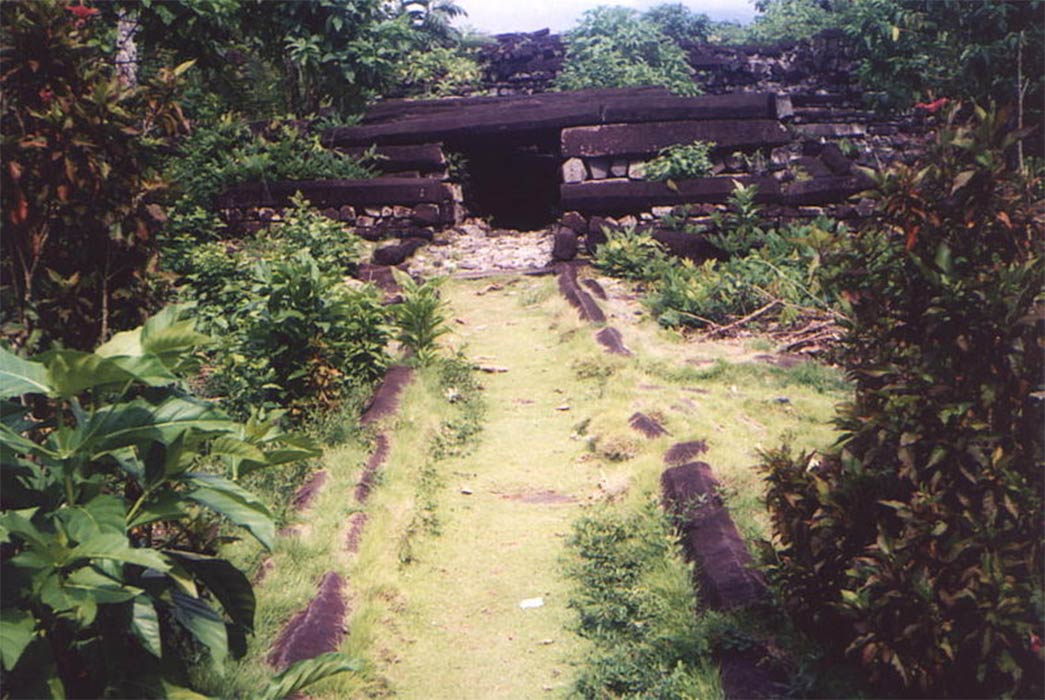
Ruins at Nan Madol (CC BY-SA 2.0)
Sunken Cities
Although often named a city Nan Madol does not correspond with one, or any other type of urban settlement. The complex was not built with practical concerns in mind. With no access to fresh water, it was not for general living. Though picturesque, neither was it a seaside getaway. It would appear that Nan Madol was primarily a spiritual centre. The relatively shallow waterways, for example, which rise only waist deep at high tide, were perhaps not solely intended to allow skiffs between the islets, but for rituals of initiation and journeys of the soul. Indeed, deeply embedded in the sacred vision of Nan Madol and its connection with water is the notion of a mirror image. This not only implies afterlife realms but also legacies of sunken cities beyond its shore. Effectually, Nan Madol was built as a memorial to a drowned predecessor.
- The Mystery of Gunung Padang, Java and the Cham
- Nan Madol: The Mysterious Ancient Coral Reef City
- Age of First Chief's Ancient Tomb Reveals Pacific Islanders Invented New Kind of Society
Pohnpei itself is said to have been settled over a wave of seven ancestor migrations that arrived on the island from the south. The seventh of these included two brother magicians named Olishipa and Olosohpa to whom the construction of Nan Madol is accredited. Olishipa and Olosohpa are said to have built the elaborate waterfront city with magic by levitating the basalt logs into the air. The brothers arrived at Pohnpei in a canoe from a sinking homeland named Katau. Katau may or may not specify another Micronesian island named Kosrae, itself home to megalithic ruins, situated 554 kilometers (344 miles) southeast of Pohnpei. Since Katau is mentioned in reference to Pohnpei’s earlier settlers, its geographical ambiguity perhaps indicates the degree to which locations on sea maps merged with mythical places in the sky seen above them.
Olishipa and Olosohpa were related to a god of thunder and rain. They also brought to Pohnpei the worship of a god of agriculture under a dynasty known as the Saudeleur. Over generations their dynasty became tyrannical and was eventually overthrown by an outsider named Isokelekel – another exile from Katau. When Olishipa and Olosohpa arrived at Pohnpei, they surveyed the island looking for a suitable location to settle their kingdom along the coast. They scaled a high mountain peak and from its vantage saw an underwater city beyond the tidal flats southeast of the island. They took this as a sign to build Nan Madol as the resurrection of the sunken ‘city’ of Khanimweiso. Allegedly, there was also another sunken inspiration behind the renaissance of Nan Madol, this time based on another submerged city named Namkhet, further out to sea beyond Khanimweiso.
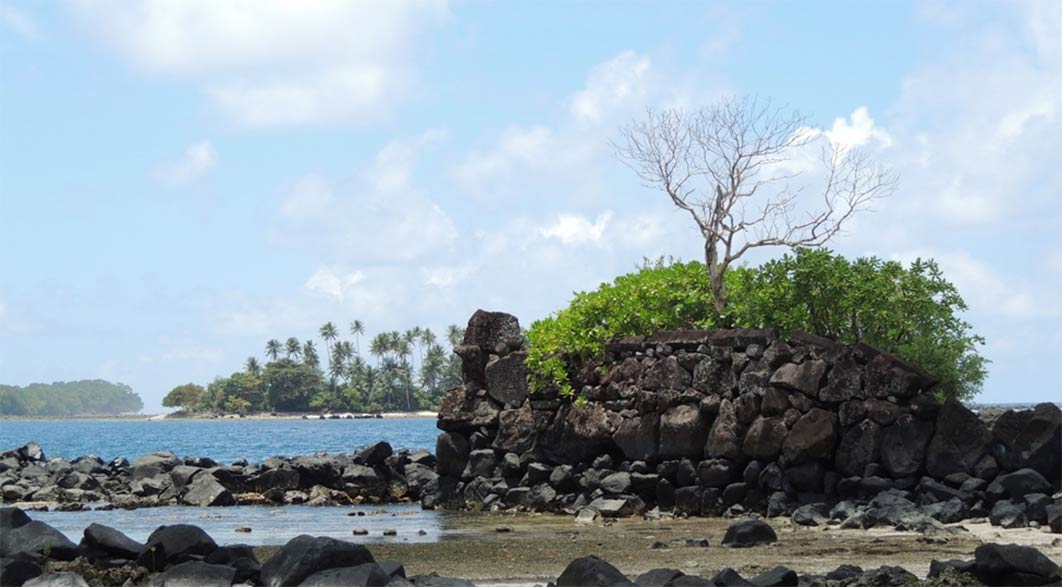
Breakwater overlooking Nahkapw Harbor and the sunken city (Image: © Alistair Coombs)
For decades, divers have reported undersea ruins at considerable depth off the coast of Nan Madol. A diving team led by Dr. Arthur Saxe of Ohio State University in 1978 confirmed some of these sightings following a series of manual surveys in Nahkapw Harbor, which is overlooked by the breakwaters of Nandauwas. Saxe’s team reported a number of coral-encrusted stone pillars, some of them in an upright position. Saxe developed a hypothesis known as ‘Blue Hole’ to explain how the structures sank. It involves a limestone cavern, which forms beneath reefs, imploding when its roof gives way. Saxe had it that Khanimweiso was built on top of a cavern that later collapsed. This would also account for the legends of tunnels below Nan Madol, some of them linked to different islets, since these caverns are characterized by interconnecting passages and ‘rooms’.
In 2013, Dr Saxe’s report was challenged by a Japanese marine archaeological survey. Following manual and multibeam sonar findings and informed by the research of a previous archaeological dive conducted by the University of Oregon in 1988-89, the team found one of the erect structures to be a natural formation rather than a coral-encrusted pillar. The Japanese researchers also question Dr Saxe’s ‘Blue Hole’ hypothesis as being unlikely, but concede that their findings do not rule out the possible existence of undersea heritage. Their survey was also confined to the harbor not outside it. Nevertheless, Nan Madol’s orientation lies in the southeast.
Island Stone Gods
To ancient island-dwellers, the ocean was an important fabric of the cosmos. It bounded all horizons. From an island-centered perspective, the limits of sight and awareness where sea and sky met and melted in sunlit azure or faded in waves of galactic expanse at night signposted the land of the dead. The ancestor world on the horizon could also refer to impenetrable marine trenches far from land, where objects might rise to the surface. Things that came to shore from this beyond, such as driftwood or anomalous marine life, possessed portent and power – a view reinforced by tradition that ancestral founders had come from outside. This horizon world would also send spirits back across the sea to the land of the living and who were able to communicate through bodies or things possessed.
The basaltic rock from which Nan Madol is built was a material of esteemed spiritual standing not only to the ancient Pohnpeians, but also to other island people far from the water margins of Nan Madol. The neighboring isles of Truk, Kosrae, Ngartik and the Marshall and Gilbert Islands were united by a basalt cult. Basalt shrines on mountain peaks were spirit places, and basalt monoliths the abodes of gods and ancestors. In addition to housing spirits, these ‘stone gods’, literally blocks of basalt, marked the place of origin of clans and embodied their founders. This widespread diffusion is naturally believed to have originated from mountainous islands such as Kosrae and Pohnpei, where basalt was quarried and then exported to the lower lands and atolls of Ngartik and the Marshall and Gilbert Islands.
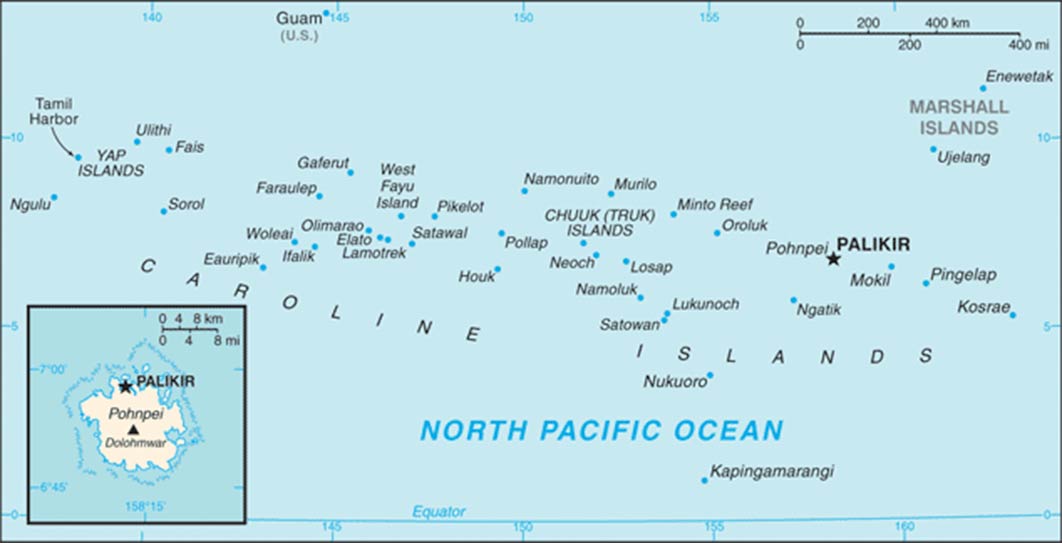
Map of the Federated States of Micronesia. (Public Domain)
Significantly, basalt was also connected to a cosmic god of thunder and rain who was named Daukatau, meaning ‘Master of Katau’, with whom the brothers Olishipa and Olosohpa had dealings. Daukatau is believed to be a proto-Oceanic title; it does not affiliate well with Pacific etymologies, although Katau, the mythical homeland of the Pohnpeians, has been translated as ‘high place’ or, likewise, ‘basalt peak’. The character of Daukatau is not far below the surface in the diffusion of this cult. In the Gilbert Islands, a thunder deity named Tabuariki – a chunk of basalt – was worshipped. As basaltic rock was perceived as a medium of supernatural powers and for domesticating the thunder god Daukatau, it is relevant that Nan Madol is built from basalt: this explains, a little, the extraordinary measures behind the quarrying and transport of this heavy mineral. Belief in the magical properties of basalt was not confined to these shores; the material found home at other places far distanced from these islands.
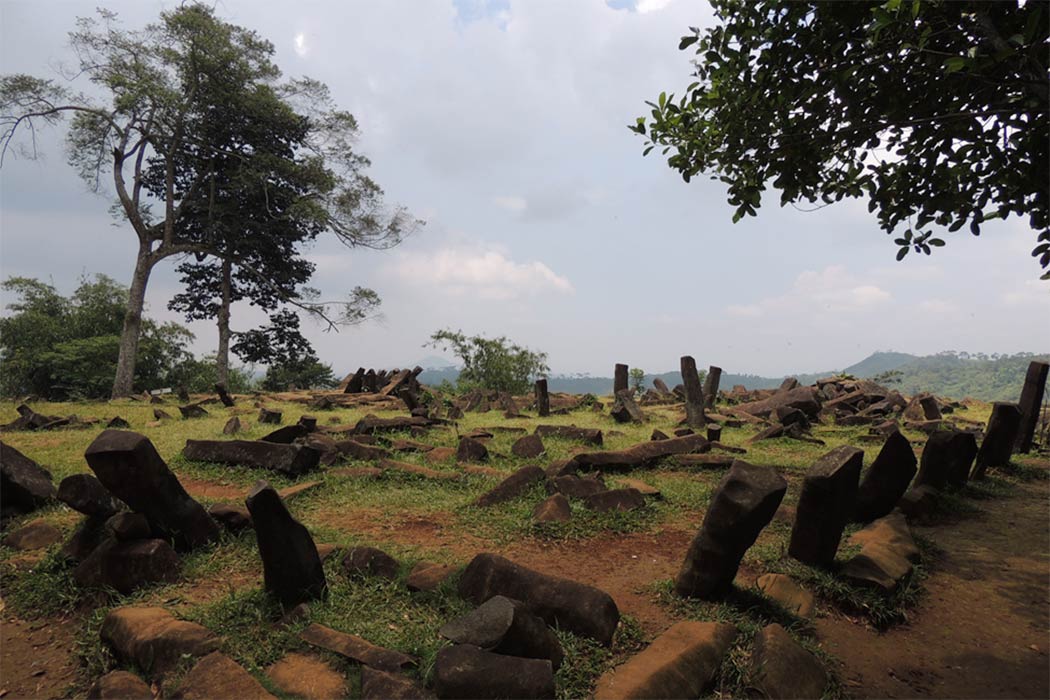
Basalt rocks at Gunung Padang (Image: © Alistair Coombs)
In the Cianjur Regency of Java, the site named Gunung Padang – ‘the mountain of light (or seeing)’ - recently emerged from archival obscurity. Built out of basalt, it is assembled upon a dormant volcano that rises sharply 2,900 feet (884 meters) above sea level. The outer layers of this pyramidal structure are stacked with columnar basalt joints. The five grading terraces at its summit are lightly picketed by the same columns. Unlike Nan Madol, the columns at Gunung Padang are staked in the ground quite randomly and appear like eldritch tombstones. Significantly, the basalt columns were similarly connected to a thunder god who took the form of a dragon and was believed to have influence over baleful meteorological phenomena accordingly.
The remoter Easter Island also had a strong tradition with this igneous material from which the Moai statues were produced. It was named Ma’ea Matariki, Ma’ea meaning stone and Matariki referencing both the ancestors and their home star cluster (the Pleiades). As living images or mediums of this energy, the statues were said to come alive twice a year when the dead would visit the living. The construction of Nan Madol, Gunung Padang and the Moai of Easter Island are wrapped in analogous auras of mystery. Nan Madol was built by a magic known as Mana-man, while the Moai were said to have been levitated by a force known as Mana (the source of which was the Pleiades). Gunung Padang is likewise said to have been built paranormally in just one night.
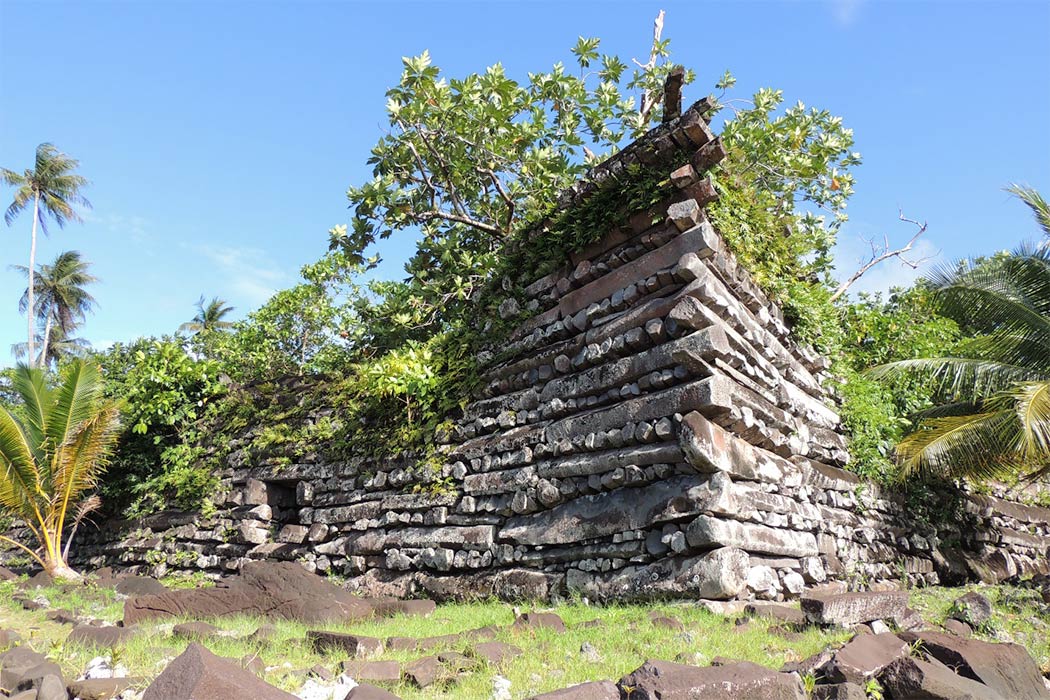
View of Nandauwas (Image: © Alistair Coombs)
Nandauwas Gateway Of The Dead
Rising steeply from the grid of waterways in the northeastern quarter of Nan Madol, towering stacks of boulders and columns bulwark the inner sanctuary of Nandauwas – the jewel in the crown of Nan Madol and the largest megalithic structure of Micronesia. Nandauwas is majestic yet austere, enigmatic and elusively forbidding. Along its blackened seaward-facing stretch it can appear ominous, an impression cast by its precipitous rise and unfamiliar outline which captures the fear the local population have of the place.
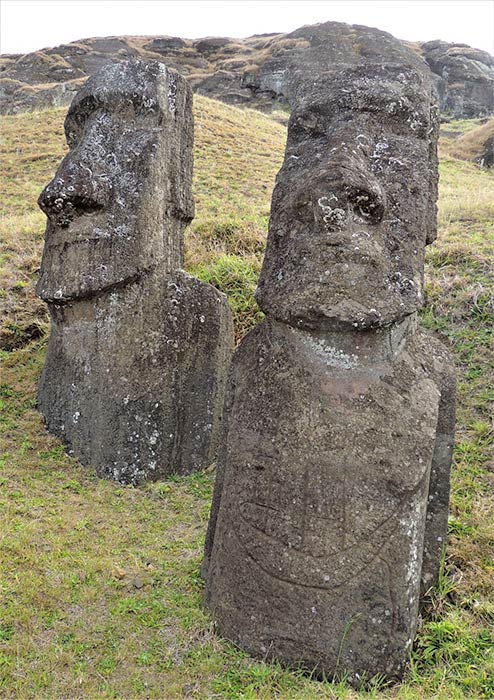
Image of a ship on one of the Maoi’s on Easter Island (Image: © Alistair Coombs)
Covering an area the size of a football pitch, Nandauwas was allegedly a mortuary complex that housed the royal tombs of the Saudeleur, although no confirmed archaeological remains of this type have ever been found there. Set back from the water-immersed perimeter base of Nandauwas, towering piles of lava slabs form a wall up to 25 feet (7.6 meters) high, its corners finished in upswept peaks as if to mimic a boat or sea-going vessel. As on Easter Island, spirit ships or soul boats were sacred items connected with ancestor worship, commemorating how the forefathers had arrived at these shores from their sinking homelands. They also enabled travel to the realm of the afterlife on the horizon. On some islands, setting an embalmed body adrift in a boat-shaped coffin was practiced. Similar to ancient Egyptian barges of the dead, boat tombs and burials have been found over the Pacific. Thus, a spirit ship may have been a prominent concept in the design of Nandauwas.
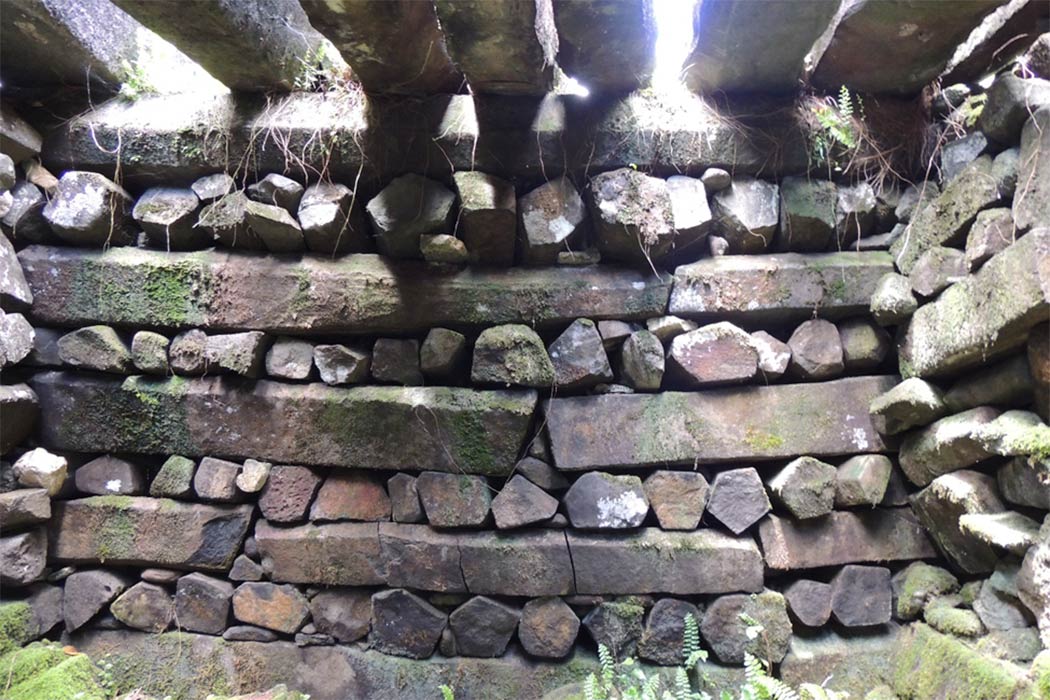
The Tomb (Image: © Alistair Coombs)
Behind its sweeping western portal are rectangular courts enclosing a central subterranean tomb vaulted by hefty five-ton basalt girders. Beneath an emerald glaze of jungle are other crypts, tunnels and courtyards and a ledge coursing along the interior of the outer walls, its purpose unspecified. Sited behind the ruins of its massive breakwater that reaches out to the harbor’s edge, Nandauwas was built on an east-west axis and is noticeably offset more east than the rest of Nan Madol. There are good reasons for this irregular orientation.
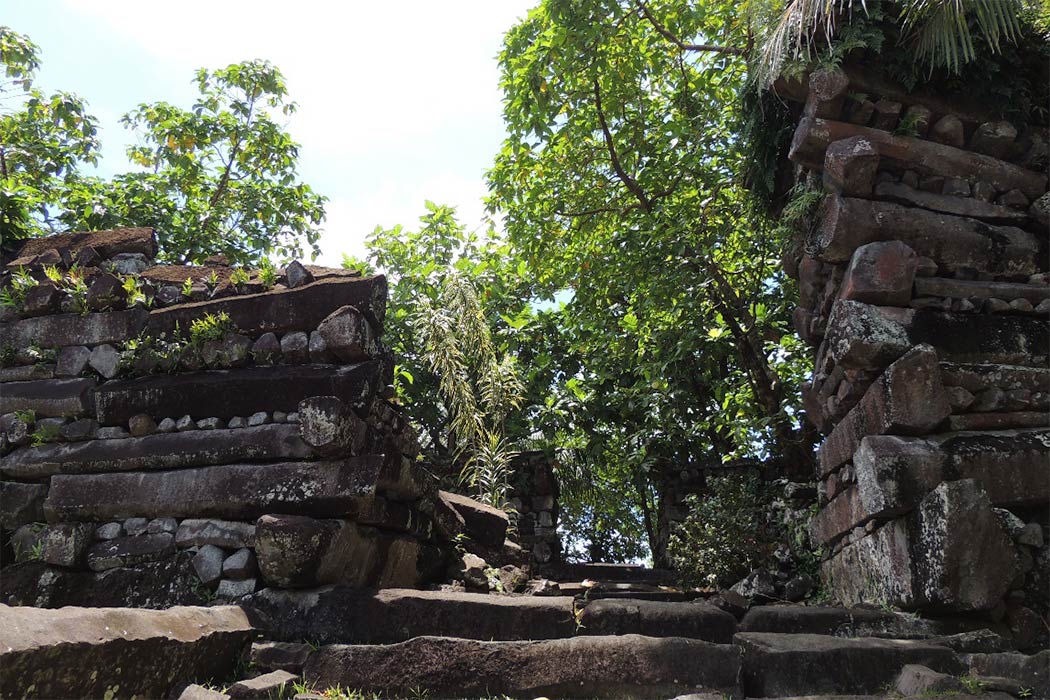
Nandauwas ((Image: © Alistair Coombs)
Aligned With Pleiades
As with other Pacific islands, the most important stars of the ancient Pohnpeians were the Pleiades. In fact, the attention given to this relatively unassuming cluster is quite astounding given the unpolluted vistas of the sky at night, especially observed from isolated isles. Both the equinoxes and the June solstice are visible from the east-facing seaward wall of Nandauwas. Perhaps more significant, marked between these solar stations at the time of Nan Madol’s use was the rising of the Pleiades. Significantly, from the seaward wall of Nandauwas they would suggestively appear to rise from the realm of the dead and sunken homeland on the southeastern horizon, providing a reason for why Nandauwas, offset from the rest of Nan Madol, would interlock with them. Moreover, the eastern wall of Nandauwas looks seaward over the harbor in a direction that not only targets Nan Madol’s legendary Khanimweiso and Namkhet sunken archetypes but also the vanished motherland of Katau, whether Katau be identified with Kosrae or not. One is also inclined to think of the seven founding ancestor voyages responsible for settling Pohnpei, which arrived on the island from this direction, reinforcing the Pleiades connection further. As with the Moai of Easter Island, did the ancestors revisit Nandauwas at certain times of the year? Perhaps like the ancestral horizon world which it faces, Nan Madol’s meaning of ‘spaces between’ might also notion the spaces between the seen and the unseen, in reference to the spirits which it periodically harbors.
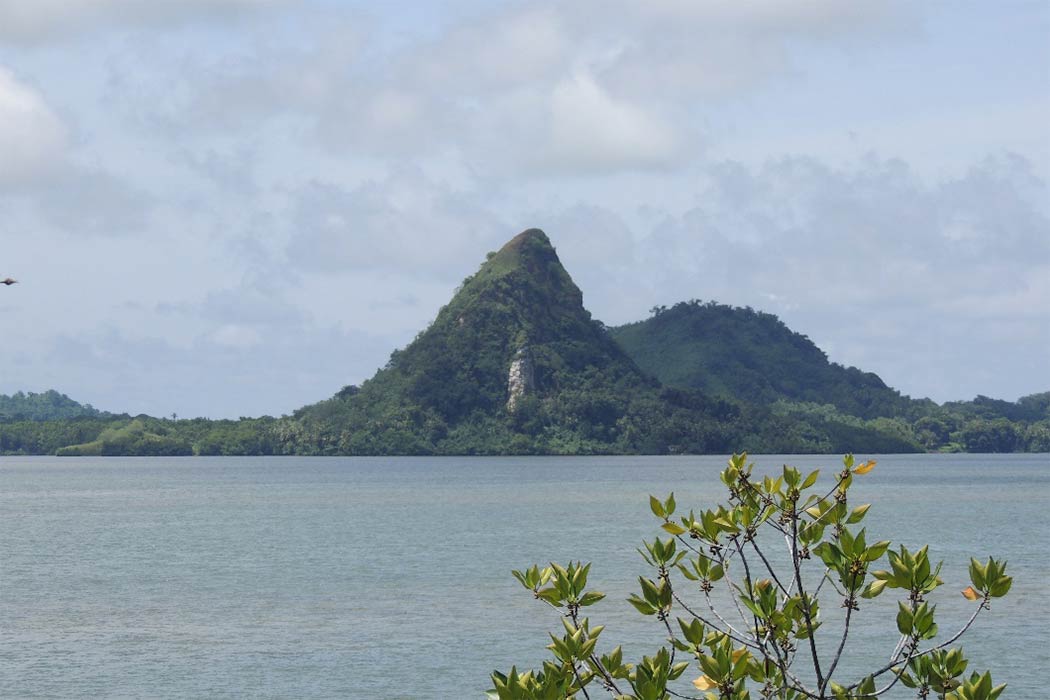
Volcanic Mountain at Pohnpei (Image: © Alistair Coombs)
One is reminded that before the dramatic rise in sea levels following the last major glacial meltdown, Pohnpei was an unrecognizably larger volcanic landmass than it currently is. For an island inviolate by marauding contact for millennia, might not Olishipa and Olosohpa’s account of an underwater city off the coast preserve the imprint of a distant cultural memory, for which Nan Madol was built as the resurrection?
Alistair Coombs studied religion and archaeology (Silk Route) at the School of Oriental and African Studies and obtains his PhD at the University of Kent in 2019. His work on prehistoric astronomy has been presented on the BBC, MSN and Science Illustrated.
Top Image: Nan Madol ruins on Pohnpei island. ( CC BY-SA 2.0)
References
Ballinger, B. S. 1979. Lost City of Stone: The Story of Nan Madol, the “Atlantis” of the Pacific. Simon & Schuster, New York
Esteban, C. 2003. Some Notes on Orientations of Prehistoric Stone Monuments in Western Polynesia and Micronesia. Archaeoastronomy: The Journal of Astronomy in Culture, 2003; XVII
Goodenough, W. H. 1968. Sky World and This World: The Place of Kachaw in Micronesian Cosmology. American Anthropologist 1986; 88(3): 551-568
Ishimura, T. 2013. Underwater Survey at the Ruins of Nan Madol, Pohnpei State. Federated States of Micronesia.
Malone, M. 1983. Micronesia’s Star-Path Navigators. Glimpses of Micronesia (Agana, Guam) 1983; 23(4) Morgan, W. N. 1989. Prehistoric Architecture in Micronesia. Kegan Paul, London.




